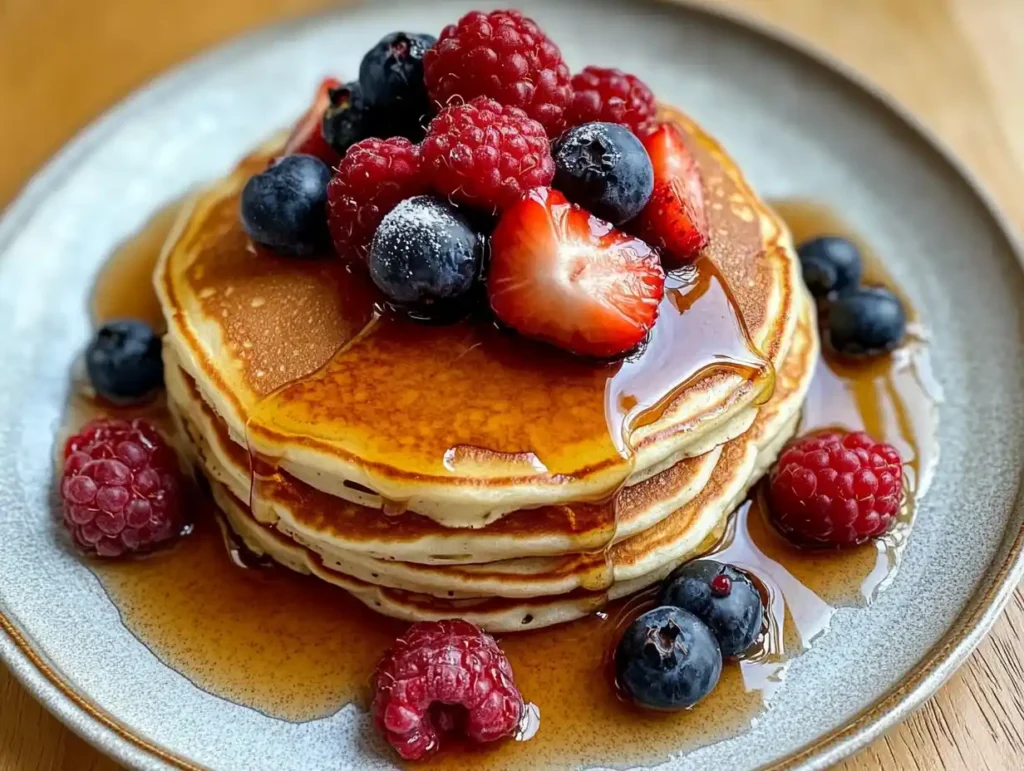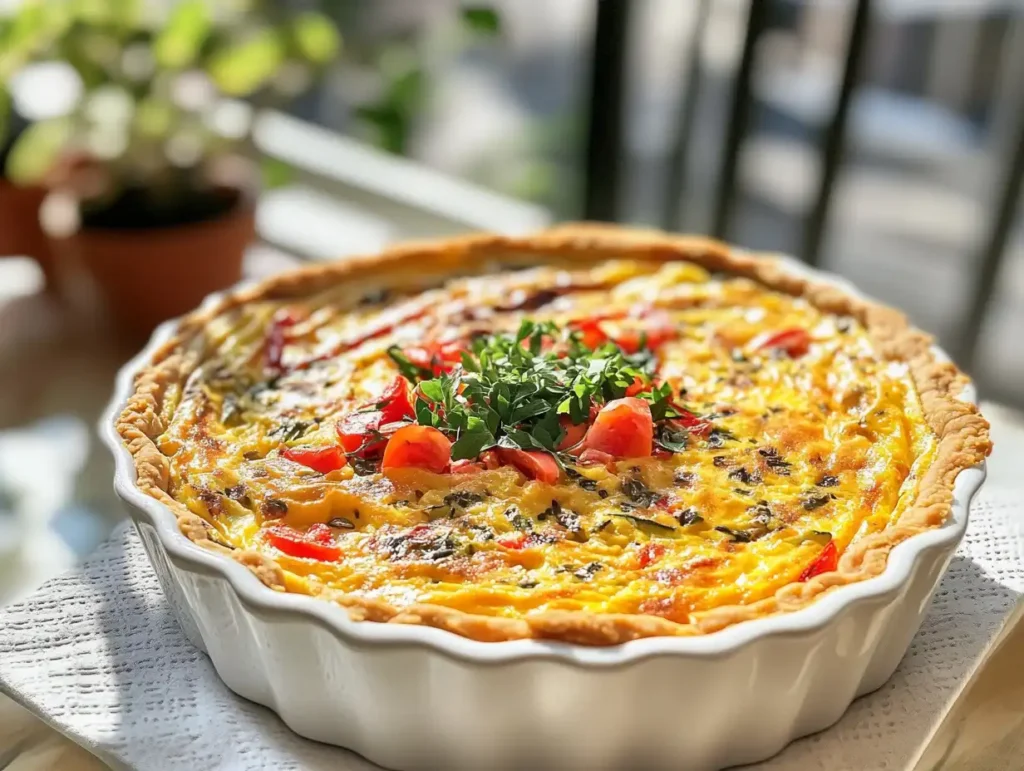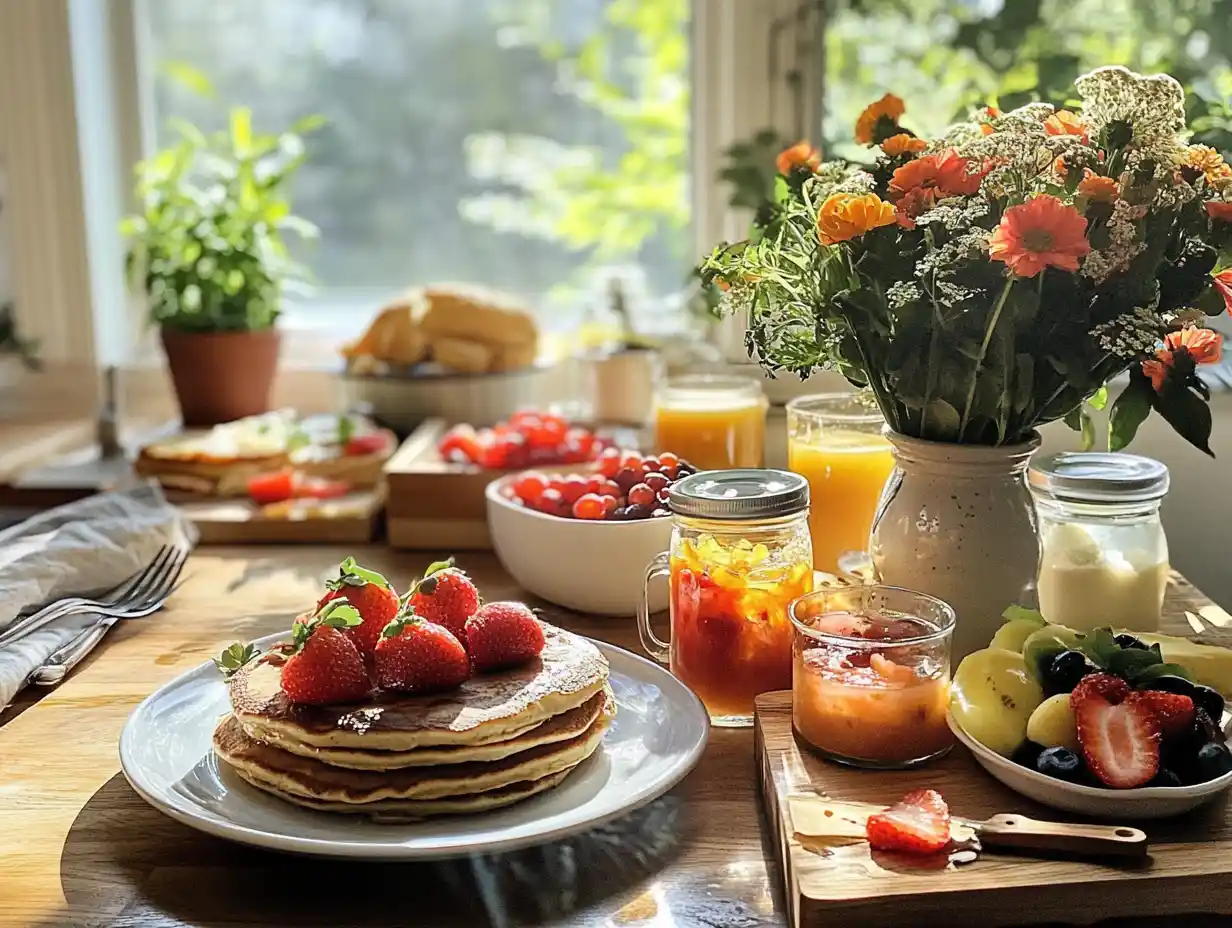Brunch has become a beloved tradition, combining the best of breakfast and lunch into a leisurely, indulgent experience. For those embracing a gluten free lifestyle, brunch offers a unique opportunity to enjoy a meal that’s both delicious and healthy. But what exactly does “gluten-free” mean, and why has it become so significant?
A Gluten Free Brunch excludes gluten, a protein found in wheat, barley, and rye. While essential for individuals with celiac disease or gluten sensitivity, going gluten free has also gained popularity among those seeking better digestion, increased energy, and overall well-being. Brunch, with its diverse menu possibilities, is the perfect meal for experimenting with gluten free options. From sweet pancakes to savory quiches, there’s something for everyone.
This guide will take you through everything you need to know to create the ultimate gluten-free brunch. Whether you’re planning a cozy meal at home or hosting a group of friends, you’ll find tips, recipes, and practical advice to make your brunch a resounding success. Let’s dive in and discover the endless possibilities of gluten-free brunching!
Table of Contents
Understanding Gluten Free Living
A gluten-free lifestyle can seem complex at first, but understanding the basics helps demystify it. Whether you’re new to this way of eating or exploring it for health reasons, this section covers the essentials.
What is Gluten?
Gluten is a group of proteins found in grains such as wheat, barley, and rye. It gives dough its elasticity and helps baked goods rise and maintain their shape. While gluten itself is harmless to most people, it can be problematic for others due to various health conditions.
Common Sources of Gluten
- Bread and baked goods made with wheat flour.
- Pasta, cereals, and crackers unless labeled gluten-free.
- Processed foods like sauces, soups, and dressings, where gluten is often used as a thickener or stabilizer.
Misconceptions About Gluten-Free Diets
Some assume that gluten-free diets are inherently healthier. However, replacing gluten-containing foods with heavily processed alternatives can lead to nutrient deficiencies. A balanced gluten-free diet relies on naturally gluten-free whole foods such as fruits, vegetables, lean proteins, and gluten-free grains.
Who Needs a Gluten-Free Diet?
Celiac Disease
Celiac disease is an autoimmune disorder where consuming gluten triggers a harmful immune response. This response damages the small intestine, leading to symptoms like abdominal pain, bloating, diarrhea, and nutrient deficiencies. For people with celiac disease, a gluten-free diet is essential.
Gluten Sensitivity and Intolerance
Those with non-celiac gluten sensitivity may experience symptoms like headaches, fatigue, and gastrointestinal discomfort when consuming gluten. Unlike celiac disease, this condition doesn’t cause long-term intestinal damage, but avoiding gluten can alleviate symptoms.
Other Health Benefits
Even for those without medical conditions, going gluten-free can promote better digestion, reduced inflammation, and increased energy levels. However, it’s essential to approach this diet mindfully to avoid missing out on vital nutrients.
Essential Gluten-Free Ingredients
Switching to a gluten-free lifestyle involves rethinking the staples in your kitchen. Fortunately, there are plenty of gluten-free alternatives available that work beautifully in cooking and baking.
Key Gluten-Free Grains and Flours
- Almond Flour: Perfect for baked goods, offering a nutty flavor and low-carb option.
- Rice Flour: A versatile choice for everything from bread to pancakes.
- Tapioca and Arrowroot Starch: Excellent for thickening soups and sauces.
- Quinoa: A nutrient-rich grain that works well in salads and side dishes.
Naturally Gluten-Free Foods
Many foods are naturally free of gluten, making them ideal staples for any diet:
- Fruits and vegetables
- Legumes like lentils and chickpeas
- Proteins such as eggs, poultry, and fish
- Dairy products like milk, cheese, and yogurt (ensure no additives contain gluten)
By focusing on whole, unprocessed foods, you can create meals that are both delicious and nourishing.
Planning a Gluten-Free Brunch
Hosting or preparing a gluten-free brunch might seem daunting, but with a bit of preparation, it can be a seamless and rewarding experience. This section provides tips and strategies to plan a brunch that satisfies both gluten-free and non-gluten-free guests.
Tips for Hosting a Gluten-Free Brunch
When hosting a brunch with gluten-free options, it’s important to ensure the food is both safe for gluten-free guests and appealing to everyone.
Prevent Cross-Contamination
Cross-contamination occurs when gluten-containing ingredients or surfaces come into contact with gluten-free foods. Follow these tips to avoid it:
- Use separate cutting boards, utensils, and cookware for gluten-free items.
- Thoroughly clean surfaces and equipment before use.
- Serve gluten-free dishes separately, with clear labels to avoid mix-ups.
Communication is Key
Talk to your guests about their dietary needs ahead of time. Some individuals may have additional sensitivities or preferences, such as vegan or dairy-free diets, that can influence your menu. Transparency ensures everyone feels accommodated and safe.
Plan Ahead
Create a detailed menu and shopping list before the day of the brunch. Having a clear plan helps you stay organized and reduces stress, leaving more time to enjoy the event.
Stocking Your Pantry for Brunch
A well-stocked pantry is the foundation of any successful gluten-free meal. Here are some must-haves for a brunch-worthy spread:
Gluten-Free Pantry Staples
- Gluten-Free Bread and Wraps: Perfect for toasts, sandwiches, or breakfast burritos.
- Flours and Starches: Almond, coconut, rice, or tapioca flour for baked goods.
- Dairy and Non-Dairy Options: Butter, cream, and plant-based milk for versatility in recipes.
- Spices and Condiments: Ensure these are gluten-free, as some spice blends and sauces may contain hidden gluten.
Baking Essentials
- Leavening Agents: Baking powder and soda that are gluten-free certified.
- Sweeteners: Honey, maple syrup, or coconut sugar for natural sweetness.
- Thickeners: Xanthan gum or guar gum to improve the texture of gluten-free baked goods.
By keeping these items on hand, you’ll be ready to whip up a wide range of gluten-free dishes at any time.
Creating a Balanced Brunch Menu
A gluten-free brunch doesn’t have to feel limited. A well-rounded menu combines sweet and savory dishes, fresh beverages, and hearty sides to keep everyone satisfied.
Mixing Sweet and Savory
Pair classic sweet treats like gluten-free waffles or pancakes with savory dishes such as an egg frittata or avocado toast on gluten-free bread. This variety ensures there’s something for every palate.
Pairing Drinks and Sides
Complement your dishes with beverages like fresh-squeezed juices, smoothies, or coffee blends. Include sides like roasted potatoes, fruit salads, or gluten-free granola to round out the meal.
Inclusive Options for Everyone
For guests with dietary restrictions beyond gluten, consider adding vegetarian, vegan, or nut-free dishes. A tofu scramble or chia pudding can cater to diverse dietary preferences without compromising flavor.
Delicious Gluten-Free Brunch Recipes
A gluten-free brunch can be a feast of flavors, offering a mix of classic dishes and creative alternatives. Here are some crowd-pleasing recipes to inspire your next brunch spread.
Sweet Treats

Sweet dishes are the heart of any brunch, and gluten free versions can be just as delicious as their traditional counterparts.
Gluten Free Pancakes
Ingredients:
- 1 cup gluten free all-purpose flour
- 1 tbsp sugar
- 1 tsp baking powder
- ½ tsp baking soda
- 1 cup almond milk
- 1 egg (or flaxseed egg for a vegan option)
- 1 tbsp melted butter or coconut oil
Instructions:
- Mix dry ingredients in a bowl.
- In another bowl, whisk wet ingredients.
- Combine wet and dry ingredients, stirring until smooth.
- Cook pancakes on a greased skillet over medium heat until golden.
- Serve with fresh fruit, maple syrup, or a dollop of yogurt.
Muffins with Alternative Flours
Create muffins with almond or coconut flour for a naturally gluten free option. Add mix-ins like blueberries, dark chocolate chips, or chopped nuts for variety.
Fruit Parfaits with Gluten-Free Granola
Layer fresh fruits like berries and bananas with Greek yogurt or coconut yogurt. Add a sprinkle of gluten free granola for crunch and drizzle with honey for sweetness.
Savory Delights

Savory dishes balance the sweetness and bring hearty options to the table.
Gluten-Free Quiche
Ingredients:
- Gluten-free pie crust (store-bought or homemade)
- 4 eggs
- 1 cup milk (dairy or plant-based)
- 1 cup shredded cheese (optional)
- 1 cup diced vegetables (e.g., spinach, bell peppers, mushrooms)
Instructions:
- Pre-bake the gluten-free crust according to package or recipe instructions.
- In a bowl, whisk eggs and milk, then stir in cheese and vegetables.
- Pour mixture into the crust and bake at 375°F (190°C) for 30-35 minutes or until set.
Avocado Toast
Use gluten-free bread as the base, then top with mashed avocado, a pinch of salt, pepper, and optional toppings like eggs, tomatoes, or microgreens.
Breakfast Tacos
Replace traditional tortillas with corn tortillas, and fill them with scrambled eggs, sautéed veggies, and gluten-free salsa. For a vegan twist, use tofu scramble instead of eggs.
Crowd-Pleasing Beverages
Complete your gluten-free brunch with refreshing and flavorful drinks.
Smoothies
Blend combinations like spinach, banana, almond milk, and chia seeds for a healthy green smoothie. For something sweeter, try frozen berries, orange juice, and coconut milk.
Coffee and Tea Blends
Offer flavored coffee options, such as vanilla or hazelnut, ensuring syrups are gluten-free. Herbal teas like chamomile or hibiscus can provide soothing caffeine-free alternatives.
Gluten Free Cocktails
Create mimosas with fresh-squeezed orange juice and gluten free sparkling wine, or mix vodka, soda water, and muddled berries for a vibrant gluten free cocktail.
Overcoming Challenges in Gluten Free Cooking
Cooking gluten free meals can come with unique challenges, especially for those new to the lifestyle. With the right techniques and awareness, you can overcome these hurdles and create satisfying, gluten free dishes without compromising on flavor or texture.
Baking Without Gluten
Baking is one of the most challenging aspects of gluten-free cooking, as gluten provides structure and elasticity in traditional recipes. However, you can achieve great results with these tips:
Tips for Perfect Gluten-Free Baked Goods
- Blend Flours: Use a mix of gluten-free flours (e.g., rice, almond, and tapioca) to replicate the versatility of wheat flour.
- Add Binding Agents: Incorporate xanthan gum or guar gum to provide elasticity and structure.
- Adjust Liquids: Gluten-free flours often absorb more liquid. Add a bit more liquid to your recipes for a better consistency.
- Let the Batter Rest: Allowing gluten-free batter to sit for 20-30 minutes before baking helps hydrate the flours and improves texture.
Common Mistakes to Avoid
- Overmixing: Unlike wheat-based doughs, overmixing gluten-free dough can make it too dense.
- Skipping Measurements: Precise measurements are crucial for balancing gluten-free ingredients.
Identifying Hidden Gluten
One of the biggest challenges in gluten-free cooking is identifying hidden sources of gluten in everyday products.
Foods and Ingredients to Watch
- Processed Foods: Many soups, sauces, and dressings use gluten as a thickener.
- Seasonings: Some spice mixes and bouillon cubes may contain gluten.
- Condiments: Soy sauce, malt vinegar, and some mustards often contain gluten.
How to Read Labels Effectively
- Look for certified gluten-free labels.
- Avoid products with vague terms like “modified food starch” unless explicitly marked gluten-free.
- Be cautious of cross-contaminated products, even if their main ingredients are naturally gluten-free.
Adapting Traditional Brunch Recipes
Transforming classic brunch dishes into gluten-free versions can be fun and rewarding.
Gluten-Free Substitutes for Common Brunch Staples
- Pancakes and Waffles: Use gluten-free flour blends or almond flour.
- Bread: Choose pre-made gluten-free loaves or bake your own with a combination of flours.
- Crusts: Create pie and quiche crusts using crushed gluten-free crackers or nuts.
Tips for Experimentation
- Start with simple recipes and gradually experiment with more complex dishes.
- Taste as you go to ensure flavors remain balanced.
- Focus on naturally gluten-free ingredients to simplify the process.
By mastering these strategies, you’ll not only overcome challenges but also unlock the full potential of gluten-free cooking.
Health Benefits of Gluten-Free Brunch
A gluten-free brunch isn’t just about catering to dietary needs—it can also provide a range of health benefits. By using wholesome, naturally gluten-free ingredients, you can create meals that nourish the body and support overall well-being.
Nutritional Highlights
Many gluten-free recipes focus on nutrient-dense, whole foods, which can have a positive impact on your health.
Packed with Essential Nutrients
- Fruits and Vegetables: Rich in vitamins, minerals, and antioxidants, these staples enhance immunity and overall health.
- Gluten-Free Grains: Options like quinoa and millet are excellent sources of fiber, protein, and complex carbohydrates.
- Healthy Fats: Almond and coconut flours provide beneficial fats that support heart health and brain function.
Improved Digestion
By avoiding gluten, individuals with sensitivities often experience reduced bloating, less discomfort, and better overall digestive health. Pairing gluten-free meals with probiotic-rich foods like yogurt can further promote gut health.
Weight Management and Gluten-Free Meals
A gluten-free diet can play a role in weight management, especially when meals emphasize whole, unprocessed ingredients.
Balanced Energy Levels
Foods with a low glycemic index, like gluten-free oats and fresh fruits, help maintain steady energy levels throughout the day, reducing cravings and the urge to overeat.
Avoiding Caloric Pitfalls
It’s important to be mindful of calorie-dense gluten-free substitutes, such as baked goods made with excessive sugar or starches. Opt for recipes with naturally gluten-free ingredients to keep your meals light yet satisfying.
Improved Well-Being
For many people, adopting a gluten-free lifestyle leads to noticeable improvements in overall well-being.
Testimonials from Gluten-Free Enthusiasts
- Increased energy and reduced fatigue.
- Clearer skin and fewer allergy symptoms.
- Enhanced mental clarity and focus.
Long-Term Health Benefits
Even if you don’t have gluten sensitivities, reducing your gluten intake can encourage a diet centered around wholesome, minimally processed foods. This shift can contribute to better long-term health outcomes, including lower risks of chronic diseases.
Frequently Asked Questions (FAQs)
Here are answers to common questions about gluten-free brunches, helping to address concerns and make the experience enjoyable for everyone.
Is a gluten-free diet healthy for everyone?
A gluten-free diet is essential for those with celiac disease or gluten sensitivity. For others, it can promote health if based on whole, nutrient-rich foods. However, switching to a gluten-free diet without medical necessity might lead to nutrient deficiencies if not planned carefully.
How do I know if a product is truly gluten-free?
Look for certifications like “Certified Gluten-Free” on product labels. Check ingredient lists for hidden gluten sources, such as malt, modified food starch, or hydrolyzed wheat protein. When in doubt, consult the manufacturer for clarification.
What are some affordable gluten-free brunch options?
- Sweet Treats: Gluten-free oatmeal topped with fruits or honey.
- Savory Dishes: Veggie-packed omelets or breakfast tacos with corn tortillas.
- DIY Staples: Homemade gluten-free muffins or pancakes using affordable flours like rice or oat flour.
Can gluten-free foods be as tasty as regular options?
Absolutely! With the right ingredients and preparation techniques, gluten-free dishes can be just as flavorful. Experimenting with spices, fresh herbs, and creative toppings can enhance your recipes.
Are oats gluten-free?
Pure oats are naturally gluten-free. However, oats are often processed in facilities that handle wheat, leading to cross-contamination. Look for oats labeled “gluten-free” to ensure safety.
What are the best gluten-free flour alternatives for baking?
Popular options include:
- Almond Flour: Adds moisture and a nutty flavor.
- Coconut Flour: Low-carb and highly absorbent, requiring less in recipes.
- Rice Flour: A versatile, neutral-flavored flour.
- Tapioca Starch: Great for improving texture in gluten-free baked goods.
Related Recipes and Tips for a Gluten-Free Brunch
If you’re planning a Gluten-Free Brunch, check out these related recipes and guides to inspire your menu:
- Protein Muffins – A healthy, gluten-free option to kickstart your morning.
- Pumpkin Banana Muffins – These delicious muffins are perfect for a seasonal, gluten-free treat.
- Vegetarian Cinnamon Sugar Donut Muffins – A soft and sweet addition to your gluten-free brunch spread.
These recipes are sure to make your gluten-free brunch both delicious and satisfying!
Conclusion
Gluten-free brunches are a delightful way to bring people together while accommodating dietary needs. By understanding the fundamentals of gluten-free living, planning thoughtfully, and exploring creative recipes, you can craft a brunch menu that satisfies every guest.
Whether you’re hosting a casual gathering or preparing a cozy meal for yourself, the possibilities with gluten-free cooking are endless. Embrace the challenge, experiment with flavors, and enjoy the journey toward healthier, more inclusive dining.
